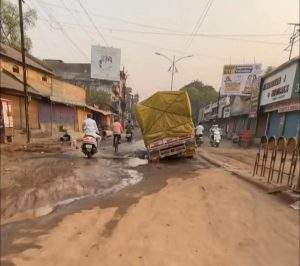
Mohammad Suleman Baig :
The issue of pollution in Chandrapur continues to worsen. According to data from the Pollution Control Board, out of the 31 days in March, 9 days recorded extremely poor air quality, 18 days were moderately polluted, and only 4 days had satisfactory air quality. The already polluted environment of Chandrapur saw a further increase in pollution levels in March, as reported by environmental expert Prof. Suresh Chopane.
Pollution Continues to Rise
All days in January and February were recorded as polluted, but the situation deteriorated further in March. During this month, 9 days had severely poor air quality, while 18 days also saw high levels of pollution.

For 26 days in March, particulate matter (PM10) was present in the air, and for 5 days, fine particulate matter (PM2.5) was recorded at concerning levels. This pollution is primarily attributed to improper road excavations and negligence in adhering to environmental regulations.
Environmental experts warn that the rising levels of fine particulate matter pose serious health risks, leading to respiratory diseases among citizens. Prof. Suresh Chopane has called for the administration to be held accountable and demanded free medical facilities for affected individuals.
Major Causes of Pollution
Several factors contribute to the rising pollution levels in the city, including:
Increase in the number of vehicles and emissions
Dust from roads and uncontrolled waste burning.
Ongoing construction activities and road excavations.
Pollution from local thermal power plants.
Experts highlight that Chandrapur is listed under the National Clean Air Programme (NCAP) as one of the most polluted cities. Therefore, any unnecessary pollution should be strictly prohibited. However, construction companies are failing to comply with environmental regulations, leading to a continuous rise in pollution. Over the past three months, improper road excavation has further contributed to increased dust and air pollution.
Suggested Measures: Construction activities should be carried out at night, and water sprinkling should be done during the day to minimize inconvenience to the public.
Health Effects of Pollution
The worsening pollution is proving hazardous, particularly for individuals already suffering from respiratory illnesses, and the number of new cases is also rising. Potential health impacts include:
✔ Asthma
✔ Bronchitis
✔ Tuberculosis (TB)
✔ Heart diseases
✔ Mental stress and depression
Necessary Measures for Pollution Control
To control pollution effectively, the following measures must be taken:
✅ Promote tree plantation.
✅ Ensure regular cleaning of roads and construct paved roads.
✅ Encourage the use of bicycles and battery-operated vehicles.
✅ Strengthen the public transportation system.
✅ Enforce strict regulations against waste burning.
✅ Make industries comply with pollution control norms.
✅ Raise public awareness about pollution prevention.
Additionally, temporary solutions like smog towers, fog machines, and artificial rain can be implemented. However, for a permanent solution, strict administrative action is necessary. Until the sources of pollution are controlled, the problem will persist.
The primary cause of increasing pollution in the city is unregulated construction and road excavations. Strict enforcement of regulations by the administration is crucial to address this issue. If stringent measures are not implemented in time, rising pollution levels could have severe health consequences for the citizens.







